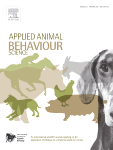Document type: scientific article published in Applied Animal Behaviour Science
Authors: Cecilie Kobek-Kjeldager, Line D. Jensen, Leslie Foldager, Louisa M. Gould, Karen Thodberg, Dorte Lene Schrøder-Petersen, Mette S. Herskin
Preview: Until recently, the pre-slaughter logistic chain of cull sows had received limited study, and their behaviour during transport remains understudied. Previously, an observational study of journeys up to 8 h in Denmark showed that the clinical condition of sows had deteriorated from departure until arrival at the slaughterhouse. The suggested main risk factors for this were journey duration, in-vehicle temperature and stationary periods, often in interaction. To disentangle these risk factors, we performed a 3 × 2 factorial study simulating commercial conditions of varying journey durations (4 h, 6 h, 8 h) and the presence of a stationary period of 30-50 min after 1-4 h of driving (long stop: yes/no). In 28 vehicle loads of sows from six herds, behaviour (posture and aggression) and in-vehicle temperature were recorded in the rear compartment holding 11-12 sows during transport to a Danish slaughterhouse. Unexpectedly, the sows were generally standing during transport (median 89-92% standing sows per hour). More sows were standing in the initial hours compared to later. Fewer sows were standing when in-vehicle temperature was higher and with higher temperature standard deviation per hour. We found that fewer sows were standing during the long stop when the latency until the long stop was longer. There was variation in the frequency of aggression among sows (median 2-3, range: 0-155 events per sow), but no differences were detected in the rate of aggression as an effect of time since departure, the presence of a long stop, or in-vehicle temperature. The frequency of aggression received per sow positively correlated with number of scratches on the front of the sow(r = 0.24). Comparing the present results with the scientific literature on finisher pigs, cull sows seem to differ in their tendency to remain standing and show aggressive behaviour throughout journeys to the slaughterhouse. We discuss possible explanations including the pre-transport clinical condition of cull sows, their sensitivity to heat stress and mixing of unfamiliar animals in a confined space as well as the experimental design choice of observing sows in the rear compartment of the vehicle. In conclusion, contrary to expectations, sows were generally standing during transport, and aggression was found throughout the journeys. The higher proportion of sows lying down during a long stop with longer time until the stop may suggest fatigue. These initial findings on the behaviour of cull sows during transport suggest challenges to their welfare.





